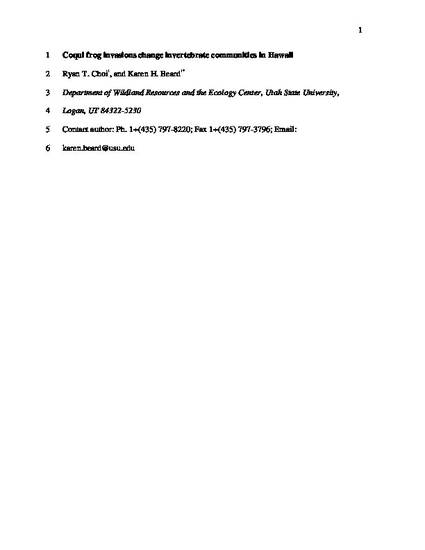
Article
Coqui Frog Invasions Change Invertebrate Communities in Hawaii
Biological Invasions
(2012)
Abstract
The Puerto Rican coqui frog (Eleutherodactylus coqui) invaded Hawaii in the late 1980s. Because the coqui reaches high densities and consumes large quantities of invertebrates, it was hypothesized to change invertebrate communities where it invades. Previous research found that coquis can change invertebrate communities, but these studies used highly manipulative, small-scale experiments. The objective of this research was to determine whether coquis create community-level changes in invertebrate communities at the landscape scale. We collected leaf litter, flying, and foliage invertebrates on both sides of 15 coqui invasion fronts across the island of Hawaii. Multivariate analyses show that coquis are associated with changes in leaf-litter communities, primarily reductions in Acari, but are not associated with overall changes in flying or foliage communities. Across sites, coquis reduced the total number of leaf-litter invertebrates by 27%, specifically by reducing Acari by 36%. Across sites, coquis increased flying Diptera by 19%. Changes were greater where coqui densities were higher. We suggest that coquis changed leaf-litter communities primarily through direct predation, but that they increased Diptera through the addition of frog carcasses and excrement. Results support previous studies conducted in more controlled settings, but add to our understanding of the invasion by showing that coqui effects on invertebrate communities are measurable at the landscape scale.
Keywords
- Amphibian; Anuran; Community impacts; Eleutherodactylus coqui; Invasive species; Non-native species
Disciplines
Publication Date
2012
Citation Information
Karen H. Beard. "Coqui Frog Invasions Change Invertebrate Communities in Hawaii" Biological Invasions Vol. 14 Iss. 5 (2012) Available at: http://works.bepress.com/karenh_beard/122/
